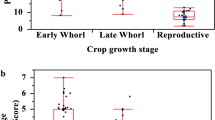Abstract
Parasitism by natural enemies of all larval instars of the fall armyworm (FAW),Spodoptera frugiperda, was quantified in 5 Honduran maize fields during the 1984 growing season. Overall, 42.0% of the host larvae were killed by the natural enemy complex. The braconid parasitoidChelonus insularis was the most common natural enemy accounting for 36.8% of the complex and causing 15.5% mortality of FAW larvae. Other important natural enemies included the nematodeHexamermis sp., the tachinidLespesia sp. and the imperfect entomopathogenic fungusNomuraea rileyi. Distinct ranges of larval instars were attacked by several natural enemy species.Chelonus insularis was an important FAW natural enemy at all larval densities observed.
Resumen
El parasitismo por enemigos naturales del gusano cogollero,Spodoptera frugiperda en todos sus ínstares larvales, fué evaluado en cinco campos de maíz en Honduras, Centro America, durante la temporada de siembra de 1984. El complejo de enemigos naturales mató el 42% de las larvas de cogollero. El parasitoide braconido,Chelonus insularis, fué el enemigo natural más común, constituyendo el 36.8% del complejo y causando una mortalidad del 15.5% de las larvas. Otros enemigos naturales importantes fueron el nemátodoHexamermis sp., la mosca tachínidaLespesia sp., y el hongo imperfecto entomopatogénicoNomuraea rileyi. Rangos específicos de los ínstares larvales del cogollero fueron atacados por varias especies de enemigos naturales.Chelonus insularis fué un enemigo natural importante del cogollero en todas las densidades de larvas muestreadas.
Résumé
Le parasitisme dû aux ennemis naturels de tous les stades larvaires de la NoctuelleSpodoptera frugiperda a été quantifié dans 5 champs de maïs au Honduras, en 1984, durant la saison. Au total, 42% des larves hôtes ont été tuées par le complexe des ennemis naturels. Le Braconide parasitoïdeChelonus insularis était l'ennemi naturel le plus commun; il représentait 36,8% du complexe, causant 15,5% de la mortalité des larves de la Noctuelle. Les autres ennemis naturels importants comprenaient le nématodeHexamermis sp., la tachinaireLespesia sp. et le champignon entomopathogèneNomuraea rileyi. Des échantillons variés de stades larvaires ont été attaqués par plusieurs espèces d'ennemis naturels.Chelonus insularis était un important ennemi naturel de la Noctuelle à toutes les densités larvaires observées.
Similar content being viewed by others
References
Alcocer, Q. B. P. L. &Méndez, M. — 1965. Estudios preliminares sobre parasitismo en larvas deLaphigma (sic)frugiperda Smith y Abbot (sic), por un nemátodo de la familia Mermithidae. —Fitófilo, 48, 5–20.
Andrews, K. L. — 1980. The whorlworm,Spodoptera frugiperda, in Central America and neighboring areas. —Fla. Entomol., 63, 456–467.
Andrews, K. L.; — 1988. Latin American research onSpodoptera frugiperda [Lepidoptera: Noctuidae]. —Fla. Entomol., 71, 630–653.
Ashley, T. R. — 1979. Classification and distribution of fall armyworm parasites. —Fla. Entomol., 62, 114–123.
Ashley, T. R., Waddill, V. H., Mitchell, E. R. &Rye, J. — 1982. Impact of native parasites on the fall armyworm,Spodoptera frugiperda [Lepidoptera: Noctuidae], in south Florida and release of the exotic parasite,Eiphosoma vitticole [Hymenoptera: Ichneumonidae]. —Environ. Entomol., 11, 833–837.
Ashley, T. R. — 1983. Growth pattern alterations in fall armyworm,Spodoptera frugiperda, larvae after parasitization byApanteles marginiventris, Campolitis grioti, Chelonus insularis, andEiphosoma vitticole. —Fla. Entomol., 66, 270–66.
Ashley, T. R. — 1986. Geographical distributions and parasitization levels for parasitoids of the fall armywormSpodoptera frugiperda. —Fla. Entomol., 69, 516–524.
Chiang, H. C. — 1977. Integrated control of maize insects in Latin America. Working paper. —7 th session Panel of Experts in Integrated Pest Control, Rome. FAW, United Nations. IPC/WP/9, Rome.
Estrada, F. A. — 1960. Lista preliminar de insectos asociados al maíz en Nicaragua. —Turrialba, 10, 68–73.
Flanders, S. E. — 1959. The employment of exotic entomophagous insects in pest control. —J. Econ. Entomol., 52, 71–75.
Gross, H. R. &Pair, S. D. — 1986. The fall armyworm: status and expectations of biological control with parasitoids and predators. —Fla. Entomol., 69, 502–515.
Hanway, J. J. — 1966. How corn develops. —Iowa State Univ. Spec. Rep., No. 48, Ames, Iowa, 13 pp.
Ignoffo, C. M. — 1981. The fungusNomuraea rileyi as a microbial insecticide. In: Microbial Control of Pests and Plant Disease, 1970–1980 (H. D. Burgess, ed.). —Academic Press, 513–538.
Lacayo, L. — 1977. Especies parasíticas deSpodoptera frugiperda Smith,Diatraea lineolata (Wer) yTrichoplusia ni (Hbn) en zonas de Managua y Masatepe. In:Memoria de la XXIII Reunion Anual del PCCMCA, Panama, 28 pp.
Leppla, N. C., Vail, P. V. & Rye, J. R. — 1979. Mass rearing and handling techniques for the cabbage looper. —Proc. Radioisotopes and Radiation in Entomology, Training Course, FAW/IAEA, pp. 59–75.
Luginbill, P. — 1928. The fall armyworm. —U.S.D.A. Tech. Bull., No. 34, 91 pp.
McGuire, J. U. & Crandall, B. S. — 1967. Survey of insect pests and plant diseases of selected crops of Mexico, Central America and Panama. —Int. Agric. Dev. Serv. ARS. USDA, 157 p.
Mitchell, E. R., Waddill, V. H. &Ashley, T. R. — 1984. Population dynamics of the fall armyworm [Lepidoptera: Noctuidae] and its larval parasites on whorl stage corn in pheromone permeated field environments. —Environ. Entomol., 13, 1618–1623.
Ortega, A. — 1974. Maize diseases and insects. In:Proc. World wide maize improvement in the 70's and the role for CIMMYT, 7, 1–41.
Pair, S. D., Raulston, J. R., Sparks, A. N. &Martin, P. B. — 1986. Fall armyworm [Lepidoptera: Noctuidae] parasitoids: differential spring distribution and incidence on corn and sorghum in the southern United States and northeastern Mexico. —Environ. Entomol., 15, 342–348.
Rechav, Y. — 1975. Biological and ecological studies of the parasitoidChelonus inanitus [Hym.: Braconidae] in Israel. —Entomophaga, 20, 365–372.
Van Huis, A. — 1981. Integrated pest management in the small farmers's maize crop in Nicaragua. —Med. Land., Wageningen, 81–6: 93–100.
Author information
Authors and Affiliations
Additional information
Florida Agricultural Experiment Station Journal Series No. 8650 and MIPH-EAP No. 146.
Rights and permissions
About this article
Cite this article
Wheeler, G.S., Ashley, T.R. & Andrews, K.L. Larval parasitoids and pathogens of the fall armyworm in honduran maize. Entomophaga 34, 331–340 (1989). https://doi.org/10.1007/BF02372472
Issue Date:
DOI: https://doi.org/10.1007/BF02372472




